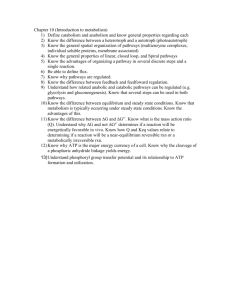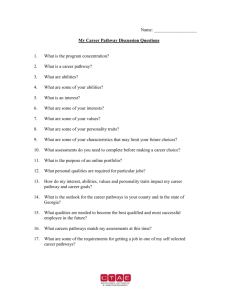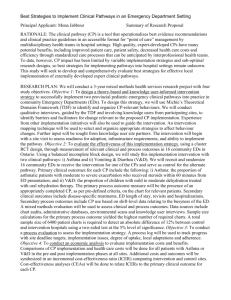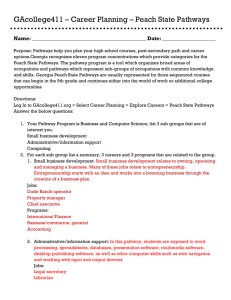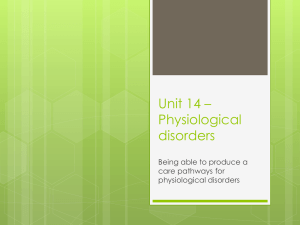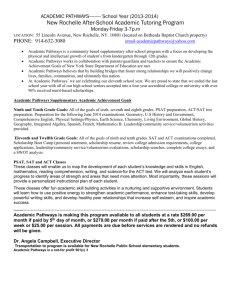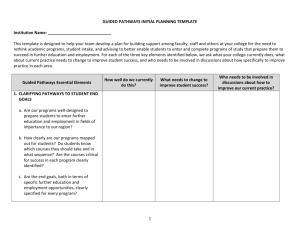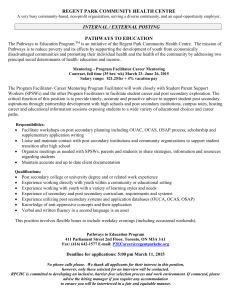Social Opportunity and Learning Trajectories
advertisement
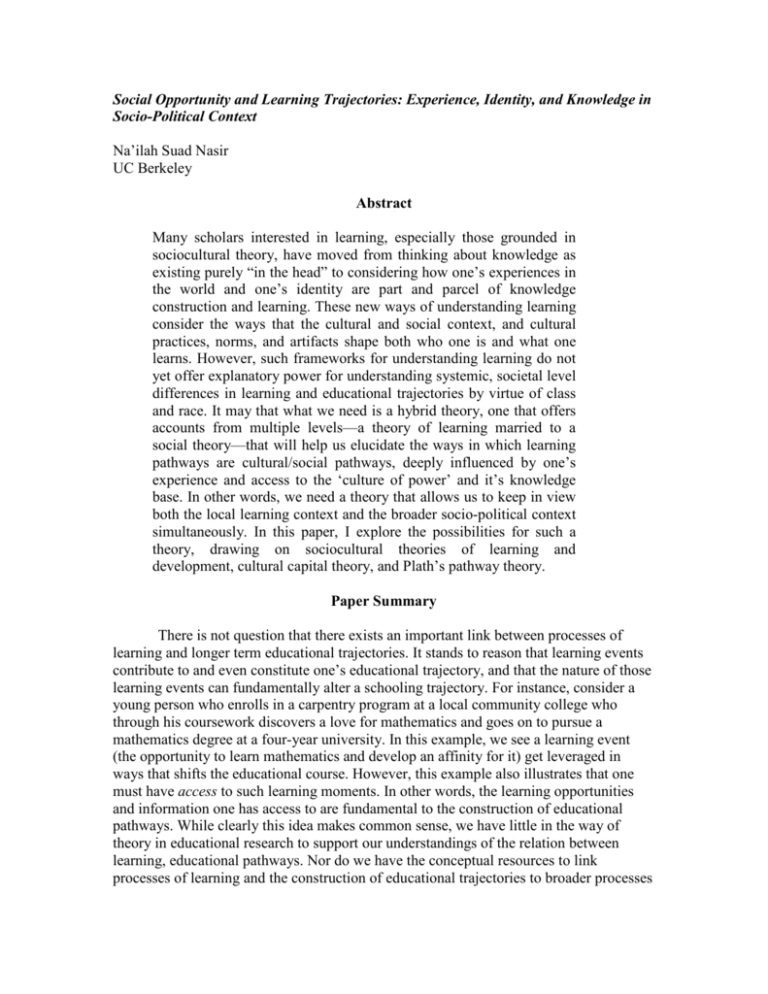
Social Opportunity and Learning Trajectories: Experience, Identity, and Knowledge in Socio-Political Context Na’ilah Suad Nasir UC Berkeley Abstract Many scholars interested in learning, especially those grounded in sociocultural theory, have moved from thinking about knowledge as existing purely “in the head” to considering how one’s experiences in the world and one’s identity are part and parcel of knowledge construction and learning. These new ways of understanding learning consider the ways that the cultural and social context, and cultural practices, norms, and artifacts shape both who one is and what one learns. However, such frameworks for understanding learning do not yet offer explanatory power for understanding systemic, societal level differences in learning and educational trajectories by virtue of class and race. It may that what we need is a hybrid theory, one that offers accounts from multiple levels—a theory of learning married to a social theory—that will help us elucidate the ways in which learning pathways are cultural/social pathways, deeply influenced by one’s experience and access to the ‘culture of power’ and it’s knowledge base. In other words, we need a theory that allows us to keep in view both the local learning context and the broader socio-political context simultaneously. In this paper, I explore the possibilities for such a theory, drawing on sociocultural theories of learning and development, cultural capital theory, and Plath’s pathway theory. Paper Summary There is not question that there exists an important link between processes of learning and longer term educational trajectories. It stands to reason that learning events contribute to and even constitute one’s educational trajectory, and that the nature of those learning events can fundamentally alter a schooling trajectory. For instance, consider a young person who enrolls in a carpentry program at a local community college who through his coursework discovers a love for mathematics and goes on to pursue a mathematics degree at a four-year university. In this example, we see a learning event (the opportunity to learn mathematics and develop an affinity for it) get leveraged in ways that shifts the educational course. However, this example also illustrates that one must have access to such learning moments. In other words, the learning opportunities and information one has access to are fundamental to the construction of educational pathways. While clearly this idea makes common sense, we have little in the way of theory in educational research to support our understandings of the relation between learning, educational pathways. Nor do we have the conceptual resources to link processes of learning and the construction of educational trajectories to broader processes of racial and social stratification in American society. How can we understand connections between learning moments, educational pathways, and the ways in which access are unequally distributed in schools and society? In this paper, I attempt to build a theory that would address this question, drawing on three bodies of theory: sociocultural approaches to learning and development (Vygotsky; Wenger; Rogoff; Saxe; Cole), cultural capital theory (Bordieu; Yosso), and conceptual approaches to understanding life pathways (Plath). Sociocultural theory forms the basis for the theoretical frame that I am proposing. Sociocultural theory derives from the seminal work of Lev Vygotsky (1968, 1972), and asserts that individual learning and developmental outcomes are deeply influenced (and are, in fact, inextricably tied to) the social and cultural context within which they occur. At the core of sociocultural theory is the idea that development occurs simultaneously on multiple planes of experience—from microgenetic development, to ontogenetic development, to the development of societies themselves, to evolutionary change (Cole, 1993). All of these planes of change influence all the other planes, with broader levels of change being constituted by change at more micro levels. Another important aspect of sociocultural theory is the important role of both artifacts and social others as carriers of culture that become points of interchange between cultural processes and individual learning and developmental processes (Rogoff, 200?, Cole, 1993, Saxe, 1999). Additionally, recent iterations of sociocultural theory have also highlighted the importance of identity processes as a mediator between culture and learning/development (Wenger, 1999; Nair & Hand, 2006). From a sociocultural perspective, identity (or one’s sense of one’s place in the world and connection to others) has profound implications for the ways in which one engages in learning settings; conversely, the ways in which learning settings engage individuals has important implications for how they view themselves. The fundamental unit of analysis proposed by sociocultural theory is cultural practices—that is the social and cultural activities that people engage in with one another towards particular shared goals. This unit of analysis supports an examination of both individuals and the cultural and social context, especially as it is carried through social interaction and cultural artifacts. It should be noted that such cultural activities often get played out in the context of institutions (Nasir, in press)—that is, cultural activities are informed by and reflect the values and norms of the institutions in which they are set. Another body of theory that I draw on in this paper are sociological theories of cultural capital (Bordieu, 1977; Bordieu & Passeron, 1990), which highlight the ways that the sets of skills and knowledge that we accumulate (cultural capital) through engaging in practices, provides, or fails to provide, access to educational trajectories that carry status, and those that carry less status. The resources that make up cultural capital are used as indexes of privilege, and their absence sets up barriers for social inclusion. I find this conceptual tool useful because like Bourdieu (1986), I are interested in how the day-to-day learning activities that individual actors draw upon to either reproduce or resist patterns of social stratification inherent within schools as institutional structures. Cultural capital refers to a notion of high status cultural attributes, codes, and signals. Cultural capital includes, “goods, material and symbolic, without distinction, that present themselves as rare and worthy of being sought after in a particular social formation” (Harker, 1990, pg 13). Important to note is that material and symbolic goods become the means in a system of exchange that confers differential levels of power and status. More specifically, one can think about cultural capital as forms of knowledge, skills, and advantages that through the processes of socialization and acquisition give one greater access to power. For example, high status parents provide their children with cultural capital by socializing them into particular attitudes and knowledge valued for success in the educational system. Cultural capital operates through interactions between individuals and institutions. However, recent criticisms of cultural capital theory have highlighted the point that Bordieu is focused on the poverty of cultural resources that exist in communities in lower social class neighborhoods, and assumes that “some communities are culturally wealthy while others are culturally poor” (Yosso, 2005, pg 76). Clearly, however, there are important resources that exist in marginalized communities of color, resources that offer rich opportunities for learning and school success. Towards this end, Yosso (2005) has developed a theory that identifies elements of community cultural wealth, including aspirational capital, linguistic capital, familial capital, navigational capital, and resistant capital. Yosso argues that these forms of capital are readily available in marginalized communities of color and point to the tension between understanding social reproduction and offering an honest portrayal of the complexity of the resources and risks that exist for learning and schooling in minority communities. Yosso sees this approach as a Critical Race Theory perspective on cultural capital, and contends that research must highlight the ways that “the cultures of Students of Color can nurture and empower them. Pg 76” While thus far, the theories that I using have focused on the nature of the cultural activities that individuals engage with, and the role of institutions and social arrangements in defining which activities individuals from different social classes and communities have access to. However, I have said little so far about how we can think about the cumulative effect of participation in these cultural and social activities. In other words, how do we understand the ways in which participation in particular activities over time constitute or lead up to educational trajectories? To support this endeavor, I draw on the work of Plath on conceptualizing life pathways, and the link between culture and such pathways. Plath sees pathways as being constructed at the intersection of culture and individual choice and meaning. While culture has a heavy hand in determining the potential pathways made available (and those which are made available to particular people), constructing a pathway is not simply following a culturally-determined road. Plath writes, “Pathways can vary in their appeal for different persons or for the same person at different phases of life.” Pg 50. Part of choosing a pathway has to do with drawing on a frame which one uses to construct meaning. The frame one chooses often implies a pathway. Thus, individuals have a choice of possible frames and pathways, but the pathways are not infinite, and they are located geographically, politically, and historically. Pathways are deeply related to identities, as how one sees oneself is reciprocally linked to the life choices that one makes. Pathways are also related to cultural goals (Saxe)—in that people construct cultural goals, then follow available cultural pathways toward those goals. I take up these ideas about pathways to inform a conception of educational pathways—which are also culturally-constructed and linked to cultural and individual goals. In this paper, one task is to explore how such pathways are informed by the cumulative effect of participation in learning events, and are differentially offered. I will use examples of learning moments along pathways in two settings—a predominantly African American urban high school chemistry class, and a math class in a school for incarcerated youth. For each, I will present a scence for a learning event, along with data that speak to the educational pathway that the learner is on, and the ways that this pathway is offered institutionally. I will also examine how the ‘offering’ of these pathways is linked to social class and race.
